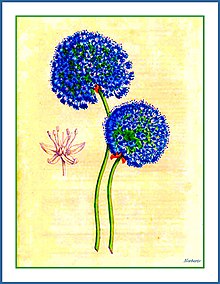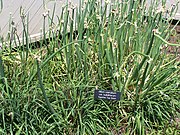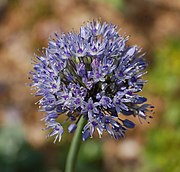
Chives, scientific name Allium schoenoprasum, is a species of flowering plant in the family Amaryllidaceae that produces edible leaves and flowers. Their close relatives include the common onions, garlic, shallot, leek, scallion, and Chinese onion.

Allium vineale is a perennial, bulb-forming species of wild onion, native to Europe, northwestern Africa and the Middle East. The species was introduced in Australia and North America, where it has become a noxious weed.

Allium canadense, the Canada onion, Canadian garlic, wild garlic, meadow garlic and wild onion is a perennial plant native to eastern North America from Texas to Florida to New Brunswick to Montana. The species is also cultivated in other regions as an ornamental and as a garden culinary herb. The plant is also reportedly naturalized in Cuba.
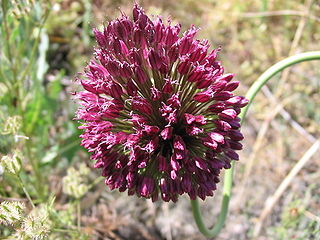
Allium sphaerocephalon is a plant species in the Amaryllis family known as round-headed leek, round-headed garlic, ball-head onion, and other variations on these names. Drumstick allium is another common name applied to this species. Some publications use the alternate spelling Allium sphaerocephalum. It is a bulbous herbaceous perennial plant.
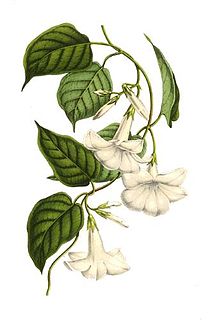
Mandevilla laxa, commonly known as Chilean jasmine, is an ornamental plant in the genus Mandevilla of family Apocynaceae.

Eucharis × grandiflora is a natural hybrid of flowering plant in the family Amaryllidaceae, native to western Colombia and western Ecuador and widely cultivated as an ornamental in other regions. It is a natural hybrid between E. moorei and E. sanderi. In horticulture it is often confused with E. amazonica, usually differing in its slightly smaller flowers. The English name Amazon lily is used for both species, but is also used for the genus Eucharis as a whole. Despite the common name, it is not closely related to the true lilies.

Allium giganteum, common name giant onion, is an Asian species of onion, native to central and southwestern Asia but cultivated in many countries as a flowering garden plant. It is the tallest species of Allium in common cultivation, growing to 1.5 metres (4.9 ft).

Louis Benoît van Houtte was a Belgian horticulturist who was with the Jardin Botanique de Brussels between 1836 and 1838 and is best known for the journal Flore des Serres et des Jardins de l'Europe, produced with Charles Lemaire and M. Scheidweiler, an extensive work boasting more than 2,000 coloured plates in 23 volumes published between 1845 and 1883.

Charles Antoine Lemaire, was a French botanist and botanical author, noted for his publications on Cactaceae.
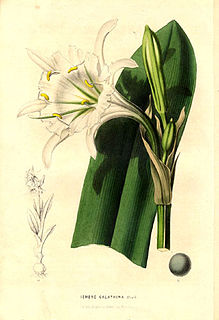
Ismene, or Peruvian daffodil, is a genus of South American plants in the Amaryllis family. The species are native to Peru and Ecuador and widely cultivated elsewhere as ornamentals because of their large, showy flowers.

Aganisia cyanea is a showy species of orchid native to Colombia, Venezuela, Peru and Brazil and widely cultivated elsewhere as an ornamental. It is remarkable because some cultivars of this species produce blue flowers, the color blue being quite rare among the orchids. They are considered difficult to maintain in cultivation without a controlled growing environment.

Cuphea ignea, the cigar plant, cigar flower, firecracker plant, or Mexican cigar, is a species of flowering plant in the genus Cuphea of the family Lythraceae. It is a tropical, densely branched evergreen subshrub. This species, native to Mexico and the West Indies, produces small, tubular, bright red to orange flowers. Each flower is tipped with a thin white rim and two small purple-black petals. The flowers, which are attractive to hummingbirds and butterflies, resemble lit cigars, hence the name ignea, which is Latin for "fiery". The genus name Cuphea comes from the Greek word kyphos which means curved or humped; this is thought to refer to the shape of the seeds. The leaves are small, elliptical and of a bright green colour. It grows to about 60 cm (24 in).

Rogiera is a genus of flowering plants in the family Rubiaceae. It has 15 species and its native range is from Mexico to Colombia.

Flore des Serres et des Jardins de l'Europe (1845–1888) was one of the finest horticulture journals produced in Europe during the 19th century, spanning 23 volumes and over 2000 coloured plates with French, German and English text. Founded by Louis van Houtte and edited together with Charles Antoine Lemaire and Michael Joseph François Scheidweiler, it was a showcase for lavish hand-finished engravings and lithographs depicting and describing botanical curiosities and treasures from around the world.
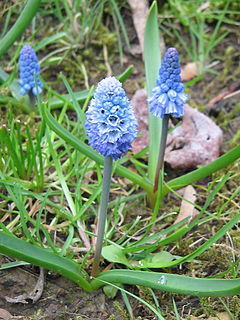
Pseudomuscari azureum, the azure grape hyacinth, is a species of flowering plant in the family Asparagaceae, native to Turkey. A bulbous perennial, it is grown in gardens for its spring flowers. The specific epithet azureum means "bright blue", a reference to its flower colour.
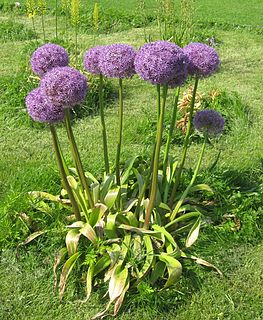
Allium hollandicum, the Persian onion or Dutch garlic, is a species of flowering plant native to Iran and Kyrgyzstan but widely cultivated as an ornamental because of its umbels of attractive purple flowers. It is reportedly naturalized in Saint Louis County, Minnesota.
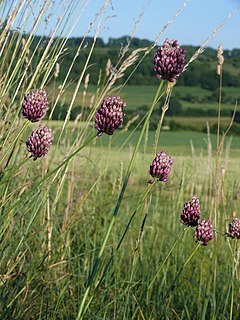
Allium commutatum is a species of Mediterranean onions in the amaryllis family. Its native range extends from Corsica and Algeria to Turkey.

Allium insubricum, the Lombardy garlic, is a species of flowering plant endemic to the Lombardy region in northern Italy. It is named for Insubria, the ancient name for the area around present-day Milan. The species is, however, widely cultivated as an ornamental because of its striking flowers. Its locus classicus is located in Canzo.

Allium schubertii, which has various common names including ornamental onion, flowering onion, tumbleweed onion and Persian onion, is a species of monocotyledonous flowering plant. It belongs to the onion and garlic genus, in the subfamily Allioideae of the family Amaryllidaceae. It occurs in the Levant and Libya.
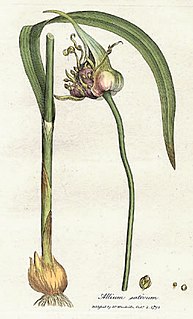
Allium is a genus of monocotyledonous flowering plants that includes hundreds of species, including the cultivated onion, garlic, scallion, shallot, leek, and chives. The generic name Allium is the Latin word for garlic, and the type species for the genus is Allium sativum which means "cultivated garlic".
